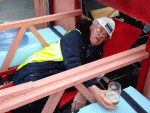TNLI
Well-Known Member
Ah, just read a previous post, so you have the same BMC 1500D as me, although if it has a Bowman heat exchanger, it's not suitable for keel cooling, unless you have removed it, as the flow rate will be too restricted by the heat exchanger. A keel cooled engine just has a circulating pump and then a plate, pipes or the rather rare radiator. If that radiator is big enough, it might not need a fan. Your cost figures look almost the same as mine, and I also have a hot water outlet, but will probably leave it blanked off.I have a morris 1500 diesel out of a J2 which is now 57 yrs old fitted with a bowman heat exchanger. My seawater pump has the same impellor it was launched with 39 years ago. In my 29 years of ownership I've had to rebuild the internals of the high rise mixer for thecost of £70 and replace one very cheap bowman end cap (£7.50) because I keep standing on it when the engine cover is removed. First time I've looked inside the heat exchanger and it's in superb condition.
I also changed the flexipipe between the engine and mixer which is 50mm corrugated stainless at £90.
I would say my total cost of £167.50 over 29 years shows cheapness and reliability .
Normal coolant operating temperature for most diesels is 80C, with a maximum of around 100C to allow for the use of water, rather than a proper coolant mix that might not boil, (Depends on the pressure cap type), until about 115C.
If you have a bigger engine, this radiator might be good. A header tank is not essential, as the radiator has a cap. It's designed for a 7.5 litre V8 and is the same size as the one I intend fitting, but has 3 rather than 2 rows of alloy grill and is 3 times the cost. Inside in winter, BUT I should be able to fit it outside for the summer in my central rescue/fishing deck area.
3Row Radiator+Shroud+Fan For Ford F100 F150 F250 F350 Bronco Pickup V8 1966-1979 | eBay
Last edited:

